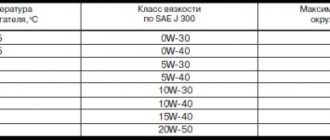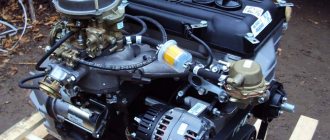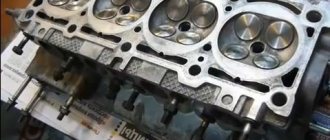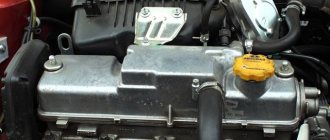The second generation Lada Kalina is an improved version of the Lada Kalina and incorporates the best developments of AvtoVAZ. In 2004, Kalina rolled off the assembly line for the first time, and since 2011, Lada Kalina has been the leader in sales volumes among passenger cars in Russia.
There have been no official tests for the media on the performance of the second generation Lada Kalina, so we will provide only preliminary characteristics. All this is in AvtoVAZ’s plans, and the numbers in the table may not be accurate.
Dynamic characteristics and fuel consumption figures are not yet known, but it has already become clear which engines, suspension and transmission will be used on Kalina 2.
Engine 2116 - for “norm” and “standard” configuration versions
The motor marked 2116 is installed on two types of equipment of the Lada Kalina 2 model. These are the “norm” and “standard” equipment. The engine is an improved version of the 11183 engine; the weight of the connecting rod and piston group set has been significantly reduced. Thirty-nine percent - engineers from Tolyatti did their best. The new version of this type of engine is better, for example, with a new camshaft drive, as well as a metal cylinder head gasket, and finally, an improved block air conditioning system. The main advantage of the latest engine model is also the mandatory heat treatment for the cylinder head. This makes the parts stronger and more durable.
All front-wheel drive Lada car models have an electric drive for the throttle valve in the engine. This engineering modernization added another ten to the number of horsepower of the engine. And now the engine has become ninety-horsepower. And due to the fact that the amount of mechanical losses was reduced, the engine torque also increased by 20 units. But it can be achieved already at 3800 rpm. Fuel consumption was also greatly reduced - which affected the increased environmental friendliness of the car. Less carbon dioxide emissions into the air.
The manufacturer assures customers that the car will travel at least 200 thousand kilometers before the first major overhaul. Also, the belt should last the same amount of time when paired with a new engine model.
Transmission Lada Kalina 2
Quite recently it became known that new models will be equipped with manual transmissions of a new type. The operation of the gearbox with engines 21116 and 21126 is currently being tested, and we know that the gearbox will have a cable drive to ensure easy shifting and partial elimination of vibration on the lever.
Moreover, the cars will receive automatic transmissions from the Japanese company Jatco. Although this automatic transmission is not new, it has already shown itself well in Nissan cars. The box has 4 gears, and forced engagement of only 1 or 1 and 2 gears. This machine is already installed on Lada Granta cars of the “norm” and “luxury” trim levels.
For the “Lux” configuration there is a motor 21126
1.6 liters and almost a hundred horsepower - these are the characteristics of this engine. This became the second engine for the Lada Kalina 2. It is available only for the “richest” versions of the car. Here, too, the connecting rod and piston group have been lightened, as well as the hydraulic valve tappets. And there will be neither few nor many of them - four pieces for each cylinder. The new engine model, like the previous one, has a so-called “Gates” belt. The guarantee for such a belt is 120 thousand kilometers of road surface. Basically, all 200 thousand are subject to its resource. This belt has been tested with great success on the Lada Priora model.
Conclusion
The Lada Kalina engine has several options. Thus, numerous variants of power units were installed on vehicles, which were developed for other models produced by AvtoVAZ. The engine has a simple design and is quite easy to maintain and repair.
The choice of oil for the Kalina engine is a very sensitive issue, since it determines how long and efficiently the main unit of the car will work. Therefore, it is recommended to fill in the fluid recommended by the manufacturer.
Updated prioromotor with index 21127
Togliatti decided to update the existing engine 21126 and add a little fire to it - now Kalina 2 with such a “heart” will have a power of 106 horsepower, with a maximum torque of 150 N*m. This was achieved by adding different intake modes - at low speeds the air passes through a long channel, at high speeds through a short one. The engine also has a new absolute pressure sensor and updated software.
True, as with everything, there are some disadvantages - when the timing belt breaks, the valves wrinkle and the connecting rod and piston group of parts suffers.
About the VAZ-21126 engine (98 hp)
| Type | gasoline (AI-95) |
| Volume | 1597 cm3 |
| Maximum power | 72.2 kW (98 hp), at 5600 rpm |
| Maximum torque | 145 Nm, at 4000 rpm |
| Configuration | in-line, 4-cylinder. |
| Cylinders | 4 |
| Valves | 16 |
| Max. speed | 192 km/h |
| Environmental standards | Euro 4 |
| Cylinder diameter | 82 mm |
| Piston stroke | 75.6 mm |
| Supply system | electronically controlled distributed fuel injection |
Engine with hydraulic valve tappets, 4 valves per cylinder, and optimized crankshaft in terms of weight, mechanical losses and durability. Engine life increased to 200,000 km. mileage To ensure service life, the following were introduced: an automatic timing belt tensioner, metal gaskets for gas pipelines and cylinder head, original crankshaft oil seals, and a modernized water pump. The muffler intake pipe with the neutralizer assembly is of an original design with reduced hydraulic resistance.
The “weak point” of the engine is considered to be: the support and tension rollers and the pump. (if they are destroyed/jammed, the belt breaks). According to reviews from car enthusiasts, the VAZ-21126 engine is significantly better than the VAZ-21124, and its only drawback is that if the timing belt breaks, the valve bends.
Diagnostic process
Toolbar that can be used for diagnostics
So, diagnostic measures using the dashboard are not complicated, and almost every owner of a Kalina car can handle them on their own. By following the step-by-step instructions below, you can carry out diagnostics on each generation of the VAZ 1117-1119 car.
Now let's move directly to the process of performing diagnostic operations:
- Reset the trip mileage indicator. There is a button on the instrument cluster for this.
- While holding the button, turn it to position I. Insert the key into the ignition and turn it to position 1.
- If everything was done correctly, all arrows on the instrument cluster begin to move from the initial positions (zero values) to the final positions.
- Switch the information display using the button on the windshield wiper stalk.
- The first screen to check is the tachometer and gauges.
- In the latter case, the software version will be displayed on the screen. Often the software version (in this case UEr 3.0 or 3.2) is displayed on the control panel screen.
- In the third case, you will see error codes that are present in the ECU. There are 8 and 4 errors in photo 6.
- Now let's decipher the errors that may appear on the toolbar screen:
The daily trip button is used to reset the indicator.
Insert the key into the ignition and turn it to position 1.
The group of instruments rotates from the initial control point to the final control point.
The software version (in this case UEr 3.0) is displayed on the dashboard screen.
Errors received during diagnostics. There are 8 and 4 errors in photo 6.
Decoding instrument panel readings
- 2 — the on-board network voltage exceeds the norm;
- 3 - fuel level sensor error detected. Appears when the sensor circuit is broken within 20 seconds.
- 4 - coolant temperature sensor error. Appears if an open circuit is detected within 30 seconds.
- 5 - An outside temperature sensor error has been detected in the vehicle. appears when there is no sensor reading for 20 seconds);
- 6 - detection;
- 7 - incorrect oil pressure;
- 8 - error or malfunction of the brake system;
- 9 — low battery level;
- E- error detection in the data packet stored in the EEPROM.
Now all that remains is to compare all the errors that popped up on the screen with those indicated above.
As practice shows, diagnosing Lada Kalina using the dashboard is quite easy and simple. This does not require any special tools or skills. It is worth noting that, according to the experience of many car owners, it is not always possible to fully diagnose everything, because wear and breakage of some contacts can be interpreted by the ECU in its own way.
For USA
restyling, 1st generation, 01.2000 - 01.2002, Jeep/SUV 5 doors.
| Equipment | Release period | Price | Engine make | Body brand |
| 2.5 l, 165 hp, Gasoline, manual transmission, all-wheel drive (4WD) | ||||
| 2.5MT Base | 02.2000 — 01.2002 | EJ251 | SF6 | |
| 2.5MT L | 02.2000 — 01.2002 | EJ251 | SF6 | |
| 2.5MT S | 02.2000 — 01.2001 | EJ251 | SF6 | |
| 2.5 l, 165 hp, Gasoline, automatic transmission, all-wheel drive (4WD) | ||||
| 2.5 AT L | 02.2000 — 01.2002 | EJ251 | SF6 | |
| 2.5 AT S | 02.2000 — 01.2001 | EJ251 | SF6 |
1st generation, 02.1997 - 01.2000, Jeep/SUV 5 doors.
| Equipment | Release period | Price | Engine make | Body brand |
| 2.5 l, 165 hp, Gasoline, manual transmission, all-wheel drive (4WD) | ||||
| 2.5MT Base | 06.1997 — 01.2000 | EJ25D, EJ251, EJ253 | SF6 | |
| 2.5MT L | 06.1997 — 01.2000 | EJ25D, EJ251, EJ253 | SF6 | |
| 2.5MT S | 06.1997 — 01.2000 | EJ25D, EJ251, EJ253 | SF6 | |
| 2.5 l, 165 hp, Gasoline, automatic transmission, all-wheel drive (4WD) | ||||
| 2.5 AT L | 06.1997 — 01.2000 | EJ25D, EJ251, EJ253 | SF6 | |
| 2.5 AT S | 06.1997 — 01.2000 | EJ25D, EJ251, EJ253 | SF6 |
Engine assembly EJ20 for Subaru Price 44,000 rub.
Automatic transmission Subaru Legacy Lancaster bh9 Price 25,000 rub.
Bumper Subaru Forester sg5 S11 restyle Price 12,000 rub.
Front bumper Subaru Forester (S10) 1997-2002 Price 9,000 rub.
Left headlight Subaru Forester (S11) 2002-2007 Price 7,000 rub.
Wing/quarter rear right Price 18,000 rub.
Specifications
So, Kalina VAZ 11183 is a 5-door C-class sedan with 5 seats. Engine capacity - 1.6 l (petrol). Fuel is supplied evenly through the injection system. The drive is front-wheel drive, although initially the manufacturer relied on rear-wheel drive, but later completely abandoned it in favor of a more maneuverable car. The gearbox is mechanical, with the possibility of upgrading to an automatic (not in factory conditions). Fuel consumption in the combined driving cycle (highway and city) is about 7.2-7.5 liters. The ground clearance is quite high - 160 mm, but it should be understood that the car was not designed to set speed records. Moreover, the fuel tank here has a volume of 50 liters. This initially indicates that the vehicle is intended for long trips.
When talking about the technical characteristics of this car, it is necessary to mention that it uses a wide wheelbase (1670 mm). Lighting - fog and adjustable (with the ability to install LED lights) headlights. At one time, these functions were considered new, so it is not surprising that buyers quite readily accepted the idea of innovation from AvtoVAZ.
As for the technical characteristics, all that remains to be said is that the car uses a McPherson front suspension, which performed quite positively during the test drive. It does an excellent job of absorbing vibrations from small potholes and responds very smoothly to rough driving. The rear suspension is standard - a straight lever, which is already traditional for the Lada company.
The manufacturer provides for the installation of wheels with the following diameters:
- R13;
- R14.
Review of Auto VAZ Kalina sedan
Lada Granta 87 l fuel consumption
A brief overview of the VAZ Kalina sedan with a 1.6 engine...
Hello dear readers of the blog RtiIvaz.ru. Today I want to talk to you about the VAZ Kalina car, in our version - a sedan, 1.6 - liter engine with 2 valves per cylinder. The car is equipped from the factory with 14-inch tires, an average configuration, which also includes electric power steering, an on-board computer and an immobilizer. Literally followed by a VAZ Kalina car with air conditioning. Kalina's exterior is made without any flashy elements, everything is done in a calm business style that fits into the concept of modern cars. The developers thought about optics, in which there are two lamps, separately for high and low beam. And the optics of the Kalina car vases themselves leave a pleasant impression, especially shimmering in the sun; by the way, the rear lights leave the same impression.
The trunk is quite spacious, measuring 400 liters, and the folding rear seats further increase the trunk volume. In addition, a well-thought-out solution for attaching the trunk lid, the hinges of which do not go inside the trunk, but fold into a special niche. This is very convenient when the trunk is fully loaded, since the absence of hinges inside allows you to use more space.
The trunk lid of the VAZ Viburnum car fits very tightly and, thanks to a reliable seal, protects from any, even pouring rain. Sometimes it happens that when loading objects with sharp edges carelessly, the seal is damaged, which breaks the tightness of the connection and allows moisture to penetrate. This nuisance in Kalina can be easily eliminated.
The doors are also perfectly fitted, which, by the way, open to a large angle, which is very convenient when boarding, especially for tall people. Kalina's rear lights are equipped with fog lights, there are stop repeaters, and a reversing light is mounted in both lights, which helps with night parking. It is worth noting that in Kalina cars, they have a very bright light, and this significantly gives confidence at night, when reversing.
The tires have a standard running size (175/65 R14), which eliminates problems when replacing them. If there is anything that will make you worry when looking for components, it is the wipers. The driver's wiper is much longer than the passenger's and there are few such options yet.
The engine behaves perfectly right from the start, showing good throttle response and as long as there are no more than three people in the car, the driver does not experience any problems. If the car is loaded and there are more than three people in the cabin, a factory limitation is felt, which can easily be reconfigured by flashing the ECU of the Kalina car.
The gear shift stroke is short; when you engage reverse gear, you need to lift the rocker, which, by the way, will be accompanied by a sound signal. The signal disappears after turning off the reverse gear.
In the urban cycle, the average consumption is 8.2-8.8l/100 km, outside the city 6.4l/100 km, after flashing the ECU - in the city - 7.8 - 8.2, on the highway - 5.5 - 6.2, and besides, VAZ Kalina cars have become noticeably faster.
You can also check out other materials:
There are several types of drive belts
Lada Granta – trial acquaintance
Lada 2107 – injector
Volvo C30 Electric – the future is near
Select the size of the seal yourself
Increased pressure
A paradoxical situation with increased compression occurs when motor lubricant enters the piston rings from above, from the side of the combustion chamber. It seals the interface and when measured the pressure surge reaches 14-15 bar.
Cause. in worn valve seals, which provide a lot of lubricant to the Niva’s combustion chamber. The exhaust fumes are desperate, the oil consumption is high, but the pistons and rings have nothing to do with it. The fault is detected when the valve cover is opened and the tappets are removed from the valves. Unsuitable caps are “oaky” to the touch or covered with cracks. Oil seals can be changed without disassembling the power unit.
Features of the 8-valve engine
A regular 8-valve engine, tested and easily repaired both in the service and in garage conditions.
Each cylinder has two valves, for intake and exhaust respectively. For a standard four-cylinder engine there will be 8 such valves.
The advantages of such a motor are as follows:
- Simplicity of design. 8-valve engines are time-tested. Compared to its 16-valve counterpart, there are fewer mechanical parts, and accordingly, repairs and maintenance will be cheaper. In addition, the absence of hydraulic compensators contributes to simplifying the design. Mechanical pushers are installed here, which are also cheap to replace and repair.
- The engine is undemanding to the quality of oil. You can use semi-synthetic lubricant.
- You can use 92 gasoline without loss of power.
- Compact dimensions as there is only one shaft at the top. Accordingly, it will be easier to get to the starter, generator and attachments.
The old 8-valve engine is not plug-in (if the valve belt breaks, the valves do not meet the pistons). It's a pity that VAZ stopped producing it in 2012.
The disadvantages of such motors include:
- Low power. Since intake and exhaust are slower than with a 16-valve engine, it will not be possible to achieve similar speeds here.
- Increased fuel consumption. Again attributed to the slow intake-exhaust cycle.
- Relatively high noise level. This is especially true at speed. In addition, mechanical pushers require periodic adjustment. As a result of wear, gaps appear on them, causing additional noise and reducing efficiency.
- The need to adjust valve clearances more frequently.
This is necessary to prevent overspending. Adjusting valves, in principle, is not a particularly complicated procedure, but it requires the presence of the necessary equipment and “heels”, which you usually don’t have in your garage.
Valve adjustment value
If we talk about an internal combustion engine, we can briefly describe the cycles of its operation. This is intake, then compression, after which fuel combustion occurs, and stroke 4 is the release of exhaust gases. On the standard Kalina 2 engine and other VAZ cars, 4 valves are used for each cylinder. Two are responsible for exhaust and two for intake. The principle of their operation is simple: when the camshaft rotates, both intake ports open simultaneously, and after a certain time, two exhaust ports open.
Valve mechanism design
The intake stroke involves the downward movement of the piston. At the same time, the intake valves open, supplying a dose of a mixture of air and gasoline into the cylinder. At the next stage, the piston begins to rise up and the intake valves close. Thus, the compression stroke occurs. Having reached the top point of the cylinder, the piston is sharply thrown back by igniting the mixture with a spark plug. Once the piston reaches extreme bottom dead center, the exhaust valves open. When it begins to rise upward, exhaust gases are pushed out at the same time.
Accordingly, without valves, the operation of an internal combustion engine is virtually impossible. Their function directly depends on the correct rotation of the camshaft. And to be precise, the appendages on it, called pushers.
As for valves, the most important parameter of their operation is the thermal gap and the correctness of its adjustment. After all, every little detail is important for the stable functioning of the gas distribution mechanism.
Purpose of thermal gap
When this gap is properly adjusted, the tappet and camshaft lobe are pressed against each other as hard as possible to ensure perfect contact between the surfaces. It is necessary to take into account that all internal combustion engine parts are mainly made of different alloys and metals (aluminum, copper, cast iron compounds). The pushers, camshaft and valve group itself are also metal. As you know, any metal tends to increase in size when heated strongly. As a result, the gap that exists on a cold power unit differs significantly from that on a warm one. Simply put, the valves are either too tight or the surfaces are not in close contact.
Adjusting the gaps is the installation of special gaps between the valve and the piston, taking into account the expansion of metals when heated. These values are so small that microns are used to measure them. However, different values are used for exhaust and intake.
Each automaker, including AvtoVAZ, has regulations according to which the required indicators are set. This is what people call valve adjustment. The manufacturer clearly regulates the frequency of such a procedure: at least once every 50,000 km. Typically, special adjusting washers are used for these purposes, which are changed at the top of the pushers.
An increased or insufficient thermal gap has an extremely negative effect on the operation of the gas distribution mechanism. In general, the operation of the entire engine is disrupted.
Differences in load on exhaust and intake valves
Almost all elements of an internal combustion engine are subject to severe thermal loads, the valve group is no exception. The diameter of their rod does not exceed 5 mm. And when fuel burns, thermal energy is released, and the temperature in a short period of time can reach 2,000 degrees. A larger gap is established on the exhaust parts due to stronger heating from the release of hot exhaust gases. This means that the metal expands at such temperatures more than at the inlet.
Preparing for work
You will need a set of tools and accessories:
- a set of socket heads with a wrench and a ratchet;
- syringe for removing engine oil;
- figured and flat screwdrivers;
- special tool for recessing valves;
- a series of special probes;
- tweezers;
- long-nose pliers;
- adjusting washers.
The procedure is actually simple and can be done independently, without the participation of specialists. To save time or if the process seems too complicated, it is better to use the services of a car service. Such work does not cost that much: the standard figure does not exceed 800–1000 rubles, depending on the region.
Adjusting valve clearances
It is carried out only on a cold engine: the optimal ambient temperature is +20 degrees. Prepare in advance:
- narrow nose pliers;
- flat screwdriver;
- heads;
- oil removal syringe;
- tweezers;
- valve desiccant (device);
- probe (0.2 and 0.35 mm);
- adjusting washers.
Remove the bolts securing the valve cover, remove it and remove the spark plugs. At the same time, inspect the camshaft cams to make sure there is no wear. Next, use a syringe to remove the oil from the head. Attach a valve recess tool to the studs. Next steps:
- Rotate the crankshaft and ensure that the marks on the timing cover and the pulley match. Next, rotate the shaft another three pulley teeth.
- Use a 0.2 mm (intake) and 0.35 mm (exhaust) feeler gauge to check the clearances. For reference, to determine which are the intake and exhaust valves, count from left to right: exhaust-intake, intake-exhaust, and so on. The adjusting washers must be replaced when the dipstick passes easily. To do this, lower the valve down using the tool, while simultaneously holding the pusher from turning with a flat-head screwdriver.
- Secure the pusher at the bottom and use tweezers to remove the old washer and install a suitable new one.
- Remove the retainer and check the gap again: the feeler gauge should pass with little effort.
Adjustment order: 1 outlet - 2 inlet, 5 outlet - 2 inlet, 8 outlet - 6 inlet, 4 outlet - 7 inlet.
Valve adjustment Kalina , with an 8-valve engine, is necessary when an unpleasant, alarming sound appears under the hood, reminiscent of a metallic clatter. This indicates that the valves “require” immediate adjustment. To perform the mentioned adjustment, you will need to prepare some tools, namely: screwdrivers (flat and Phillips), long-nose pliers (or tweezers), a set of feeler gauges, washers for adjusting the required size, a 10-mm wrench (head) with a knob, as well as a special device for adjustment.
I would immediately like to warn motorists that the adjustment of the Kalina valves is carried out only on a cooled power unit, nothing else, otherwise the set gaps will not meet the required technical standards. Remove the valve covers and install the shafts, crankshaft and camshaft according to the marked marks. In this case, the pistons of cylinders 1 and 4 must be located at TDC of the mechanism. There are different methods for adjusting valves; we will choose a more accelerated one, in which we will have to rotate the crankshaft less, and we will adjust four valves at once.
So, initially we measure the gaps where the camshaft cams are raised above the valves. In this case it is 1,2,3,5 valves. The thermal clearances for the Kalina intake valves correspond to 0.20 (+0.05mm), and for the exhaust valves they correspond to 0.35 (+0.05mm). The valves are calculated from left to right, first exhaust-intake, then inlet-exhaust, and so on. Gaps that do not correspond to the nominal value are adjusted using shims. Now, install the adjustment bar on the valve cover studs and secure it by tightening the nuts.











